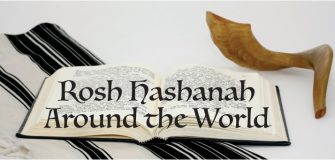Mishegoss – Rosh Hashanah Foods
Beyond Apples and Honey






Beyond the apples dipped in honey and a round challah there are many other foods that belong on your Rosh Hashanah table.
The Talmud (Keritot 6a) states, “Now that you have said that a sign is a substantial matter, a person should be accustomed to eat, at the start of the year, gourd, fenugreek, leeks, beets, and dates, as each of these grow and multiply quickly, which is a good omen for the deeds of the upcoming year.” Here is a list why these foods may be mentioned and some other symbolic Rosh Hashanah foods we should put on our plates to start the year.
The first food that is mentioned is gourds, or “k’ra.” The word “k’ra” sounds both like the Yiddish work “karet,” meaning “cut-off ” or “tear.” By eating gourds or squash, people express the hope that any negative decrees or judgments against them will be “cut off ” or “torn away” and they will be blessed with a positive and favorable year.
The second food mentioned is fenugreek or “rubia.”. The word “rubia” sounds like the word “yirbu,” the word for “increase.” We eat this food that contains the request “may…our merits increase.” Black-eyed peas and green beans are also considered rubiyah in Aramaic and Hebrew.
The third food mentioned is leeks or “karsi” is similar to “kares,” to cut off/ destroy.” We eat this food asking that our enemies be destroyed.
The fourth food mentioned is beets or “silka.” The word “silka” sounds like “siluk” the word for “remove.” We eat beets desiring any negative influences to be “removed” from our lives.
The fifth food mentioned is dates: When consuming dates, a special blessing is often recited that includes the phrase “yitamu chataim,” or “may sins be consumed.” By eating dates and reciting this blessing, we wish that any sins or negative aspects will be “consumed” for a fresh start for the new year.
Fish Heads are often served representing the head of the year. Other interpretations are that we hope to be at the “head” (leader) rather than the “tail” (follower) in the year ahead, symbolizing leadership, authority, and success. Or it may be used to show how we can be the “head” of our endeavors to have a year filled with achievements.


Pomegranates are a new year staple as the seeds symbolize abundance, fertility, and good deeds. The crown-like calyx at the top of the fruit is believed to have 613 segments, representing the 613 commandments in Jewish tradition.
Carrots are often served as the Hebrew word for carrots is “gezer” which is similar to “g’zar” the Hebrew word for decree. Likewise, the Yiddish word for carrots is “mern” and the Yiddish word for “more” is “mer.” We eat carrots to remove negative decrees and for increased blessings.
On the second night of Rosh Hashanah, it is a custom to eat a “new fruit,” one that has not been eaten in a year or for a very long time. This tradition helps identify the newness of the year and often is accompanied by a Shehecheyanu blessing.
There are also some foods that we should avoid at Rosh Hashanah.
One food that we should avoid is nuts and more specifically walnuts. Some Jews avoid nuts because the numerical value of nuts is equal to that of “sin.” Others avoid nuts since they tend to increase saliva and phlegm, making prayer difficult.
Finally, as we set our menu we should remember that the Kitzur Shulchan Aruch (129:9) writes that there is a minhag not to eat bitter or vinegary foods on Rosh Hashanah, but rather to eat sweet foods for a sweet year.
May we all be inscribed in the Book of Life for a happy and healthy, sweet new year!

























